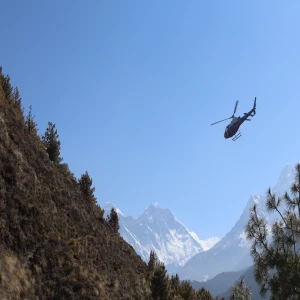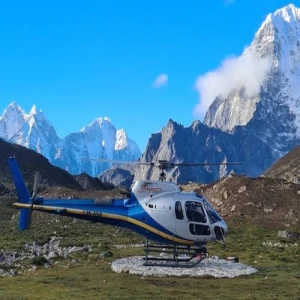Everest Base Camp Trek Return By Helicopter is a unique tour options, which is quite popular among tourists. It is a blend of two beautiful modes of touring the home of the world's tallest peak, a Trek and a Helicopter Tour. This unique voyage is a must for travelers for many reasons. That is why Mountain Rock Treks is delighted to share this way of Everest Base Camp Trek with you.
On Everest Base Camp Trek Return By Helicopter, you'll travel in two ways. First, you'll walk on the famous trail of Everest Base Camp. Then, later, reaching the base camp and witnessing the popular site, you'll return by helicopter to Lukla, enjoying the mouth-opening vision of the Khumbu Region and escaping all the hikes. We've been saying it is a complete way to explore Everest Base Camp and Everest Region.
It is a hand-knitted package for trekkers who want a complete Everest adventure. The doers of this itinerary will encounter what the region is all about via trekking and Helicopter touring. Travelers will explore the beauty both from the land and the air.
Likewise, this plan saves at least 3 to 4 days and a lot of sweat which would instead require completing the whole trek on foot. For this reason, the program can be a good option for travelers with time constraints.
So Everest Base Camp Trek and Return By Helicopter Tour commences from Kathmandu. You will join a morning scenic flight to Lukla to join the trekking trail of Everest Base Camp. Walking on the picturesque route, you will pass Phakding and Monjo to reach Namche Bazaar. You will spend a full rest day in Namche Bazaar's pleasing vicinity.
After the acclimatization, you will continue the trek via Tengboche, Dingboche, and Lobuche to arrive in Gorakshep. Around here, you'll pass through the awe-inspiring villages of Sherpaa. And finally, the continuous trek of more than a week will lead you to the legendary landmark, Everest Base Camp(5,364m). Then the next day, you will trek towards Kala Patthar(5,545m), a must-visit site for Everest mountain vistas.

Following the visit to Kala Patthar, you will join a helicopter to return to Lukla. You will fly straight to Lukla from Kala Patthar in one hour, dodging the trek of 3-4 days. While returning, the clear and vast views of the entire Khumbu Region will leave your mouth open. And from Lukla, you'll make a return flight to Kathmandu to conclude the tour.
In conclusion, Everest Base Camp Trek Return By Helicopter is a worthwhile experience. This expedition will give you all that the Everest Region has: the mountains, the Sherpas, the hanging bridges, the lush greenery, the iconic villages, the broad valleys, the ancient Buddhist shrines, the drove of mules, and more. Choosing this itinerary will allow you to experience all of that by saving several days and a lot of labor.
Everest Base Camp Heli Trek Route
Our most popular, Everest Base Camp Heli Trek, is a nine-day program. The beautiful journey begins with a quick flight from Kathmandu to Lukla (2,860 m/9383 ft). Then, it takes around half an hour to land at Lukla's Tenzing Norgay Airport at 9,334 ft (2,845 m), one of the most scenic airports in the world.
We will do all the necessary paperwork and breakfast in Lukla after the arrival. Now, we will descend from Lukla to walk into a green trail leading to the Dudh Koshi River riverbed at a distance of 33.7 km/ 33700 m of the eastern part. And continuing along the river, we will reach Phakding 2,610 mm/ 8562 ft, where we will spend the first night of Everest Base Camp Heli Trek. Trekkers should be a little careful from now on and watch out for the symptoms of acute mountain sickness.
The next day, the route heads towards Namche Bazaar, a Himalayan town at 3,440 m/11286 ft. While going to Namche, we'll cross Dudh Koshi River several times via swinging bridges, enter Sagarmatha National Park, and cross some Sherpa settlements that range in elevation from 2,845 to 8,848 m (9,334 to 29,029 ft). And finally, arriving in Namche, we'll enjoy the vibrant life around the town.
Next, we'll spend an acclimatization day in Namche Bazaar. That means we'll be around Namche Bazaar for another night. After a must-acclimatization day in Namche, we'll leave Namche's happening ambiance. We will take an ascending trail to do that.
Out of Namche, we'll pass via a straight but rough trail to Tengboche 3,860 m/12664 ft, a beautiful hamlet with Tengboche Monastery 3,867 meters (12,687 ft). We'll settle in Tengboche's serene surroundings. We'll leave for Dingoche 4,410 meters (14,470 ft).
Via a more rugged and higher trail the next day. We'll enjoy the walk full of beautiful mountains like Ama Dablam 6,812 meters (22,349 ft), Lhotse 8,516 meters (27,940 ft), Pumori 7,161 m (23,494 ft), Everest, and other peaks. And we'll end up in Dingboche.
We'll have another acclimatization day in Dingboche at 4,410 meters (14,470 ft) to prepare for the higher parts of the trek. This day will happen around Dingboche, performing glorious mountain panoramas. And we'll spend another night in Dingboche. After that, we'll take a road towards Lobuche, where we'll cross several terminal moraines of Khumbu Glacier of 4,900 m (16,100 ft) at its terminus to 7,600 m (24,900 ft). After that, the path forward is rougher. On this day, we'll trek up to Lobuche, a breathtaking stop on the trail to Everest Base Camp.
From Lobuche, we'll hike on the road to Gorakshep, 5,164 meters (16,942 ft), the last human settlement before Everest Base Camp. We'll reach Gorakshep by enjoying the displays of mountains and grinding on a rough path. Then, we'll trek to Everest Base Camp to appreciate the milestone on the same day. After that, we'll return to Gorak Shep for the night.
Early in the following day, we'll hike towards Kala Patthar, 5,644 m/18517 ft, the vintage viewpoint of the region. We'll enjoy the mountains and scenery of the place. After enough of the views, we'll join a helicopter to fly back to Lukla. It will take roughly one hour to reach Lukla. And on the Next day, we'll fly back to Kathmandu. The given process is how We will do the Everest Base Camp Heli Trek Route.
A place to visit in Everest base camp trek return by Helicopter
- Lukla airport: Popular as most people start trekking to Everest Region from here, Gateway to Everest. Most dangerous airports in the world. Get a flight from Kathmandu.
- Namche Bazaar: Unofficial capital of the Khumbu region of Nepal. Famous as a tourist hub for trekkers and travelers. Get the first view of Mount Everest. Stay place for acclimatization before heading towards Everest Base Camp. Shops promote local products like traditional handicrafts, including woolen, wooden and metallic products.
- Everest Viewpoint: Few hundred feet above the Bazaar, you can get the first glance of Mount Everest in the EBC trek and the stunning view of the Khumbu valley. A place blessed with the best idea.
- Everest View Hotel: Offers mesmerizing views of peaks. From every room, guests can submerge in the hypnotizing scene of Mt. Everest. They are listed in the Guinness Book of World Records (2004) as the Highest Placed Hotel globally at 13000ft. An ideal spot from which we can appreciate the lovely scene loaded up with evergreen fir trees, bushes, and rhododendron timberlands.
- Khumjung: One of the oldest villages in the Khumbu region, untouched by the modern world. It lies at an altitude of 3790m above sea level. Khumjung comprises mainly the Sherpa and Gurung ethnicity. Main attractions: Sacred Cave of Padmasambhava, Khumjung School, and Khumjung Monastery.
- Tangboche Monastery: One of Nepal's most famous Tibetan- Buddhist monasteries. The most significant monasteries in the Everest region are at 3867m above sea level. Midway to the route to Everest. Ancient mani stones surround it, and a prayers flag. It attracts a large number of tourists every year.
- Khumbu Glacier: One of the largest glaciers in the Khumbu region, located between Mount Everest and the Lhotse-Nuptse ridge. World's most enormous glacier with an elevation of 4900m. It flows between the two mountains. It has an enormous icefall, the Khumbu Icefall. It started to melt but not as fast as other glaciers because of its high altitude.
- Kalapathar viewpoint: Known as a viewpoint to Everest within an elevation of 5644.5m. Extremely popular, especially during the high season. Get a glimpse of Mt.Everest, Nuptse, Changtse, and Lhotse. Can reach Kalapathar within 2-3 hours from Base Camp.
- Helicopter View: You can watch the highest peaks and valleys near them from the top through Helicopter. You can get a close view of Mt. Everest and other pinnacles.
Everest Base Camp Heli Return Trek Packages 2026-2027
Everest Base Camp Heli Trek is one of the most demanded treks in the Everest Region. Consequently, Trekkers take no time to decide on this itinerary for its particular highlights. Typically, Everest Base Camp Heli Trek is a nine days long trek. But we've been offering varied Everest Base Camp Heli Trek Packages.
Mountain Rock Treks is one of the best Everest Base Camp Trek and Return by Helicopter organized company. For our clients, we customize EBC Heli Trek as per their preferences. Our best Everest Base Camp Trek Helicopter return packages 2026 are 7 Days Everest Base Camp Heli Trek, 5 Days Everest Short Trek, and 12 Days Everest Base Camp Helicopter Trek.
We can tailor Everest Base Camp Heli Trek Packages from 5 to 12 days. We can manage that if you want to take the Everest Base Camp Helicopter Tour. All of our packages are made by our expert team. Please tell us your preferences, and we'll put the best deal on the table.
Everest Base Camp Trek Back by Heli Food and Accommodation
- What kind of food do you want on the Everest base camp helicopter return trek?
You can have food items across several cuisines on the trail, like Indian, Chinese, Continental, and Local.
Dal Bhat, a local Nepali dish, is the most popular food on the trek. Alongside, you can get meals such as pizza, spaghetti, noodles, momos, sandwiches, bakery items, eggs, porridges, etc. Beverage options like coffee and tea are also available throughout the trek. In addition, many teahouses, cafes, and restaurants are on the trail. From lavish to low-budget, we'll take you to places for meals as per your selection.
Likewise, accommodation is not a problem on EBC Helicopter Trek. There are plenty of luxurious economic teahouses, hotels, and lodges along the trail. You will Provide the best upgrade accommodation facilities in great places and vice versa. Once again, it is your pick what kind of service you want. We'll find great places to sleep if you are a lavish lover. And if you are a budget-friendly traveler, we can get such accommodation too. We have plenty of options out there on the trail.
EBC Heli Trek - Our Most Popular Packages 2026-2027
We have been running helicopter treks and tours in the Everest Region for some time. And we've guided many Everest admirers through our varied packages.
Here are our most popular Everest Base Camp Trek Helicopter Return Packages for 2026:
- 7 Days Rapid Everest Base Camp Trek Return By Helicopter
- 8 Days Everest Base Camp Trek Helicopter Return
- 9 Days Everest Base Camp Heli Trek
- 10 Days EBC Heli Trek
- 13 Days Premium EBC Heli Trek
You can choose the itinerary that best suits your time and choices. Then, you can call us for detailed information about the above packages. Then, we'll talk you through it thoroughly.
Everest Base Camp Trek and Helicopter Ride Back Price
The Everest Base Camp Trek Back by Helicopter 10 Days costs US$ 2850 per person. However, you can get good discounts on a group trek.
A maximum of 5 people can join EBC Heli Trek. For anyone in a group of 2 to 5 people, the Everest Base Camp Trek and Back by Helicopter costs US$ 2850. You will get a discount of US $ 250 if you are a group of 5 pax.
Nevertheless, the cost can differ due to several factors such as accommodation and food services, traveling season, mode of transportation, number of crew members, and extra services. These various determinants can make Everest Base Camp Trek Back by Helicopter Costs go up and down.
We have Every Month's Departure. Please Check Out our Month wise cost and Fixed Departure.
Flight Date | Starting Cost US$ | Book now |
|---|---|---|
January | 2850 | |
February | 2850 | |
March | 2850 | |
April | 2850 | |
May | 2850 | |
June | 2850 | |
September | 2850 | |
October | 2850 | |
November | 2850 | |
December | 2850 |
NOTE:- WE ALSO HAVE FESTIVAL OFFER FOR EVEREST BASE CAMP TREK RETURN BY HELICOPTER TOUR FOR NEPALESE AND INDIAN PASSPORT OR CITIZEN HOLDERS. JUST YOU CAN CONTACT US.
Everest Base Camp Trek return by Helicopter Difficulty
Everest Base Camp Trek is a moderate trek. It is not one of the most strenuous treks in Nepal and not the easiest one. This trek has a high altitude, steep uphills, rough terrains, daily trekking of 5-6 hours, and extreme weather. Trekkers on Everest Base Camp Trek have to face all these difficulties. If you are an experienced and skilled trekker, you'll have minor challenges on the trek. But if you are not, you will have a challenging hike. That is why we advise beginners to prepare and train before the tour.
Or, beginners can reach Everest Base Camp with our famous Everest Base Camp Helicopter Tour. The Helicopter will take you straight to the base camp and back to Kathmandu. No need for trekking at all.
Mt Everest Base Camp Trek and Helicopter Back from Gorakshep
You will join a helicopter Flight from Kalapatthar for nine days at Everest Base Camp Trek and Return by Helicopter tour. However, you might want to fly back from Gorakshep, the nearest teahouse site from Everest Base Camp and Kala Patthar. In that case, Mt Everest Base Camp Trek and Helicopter Back from Gorakshep are available.
If you wish, you can join a helicopter from other sites like Namche Bazaar, Tengboche, Dingboche, and Lobuche. Or if you want to add a helicopter tour in other treks of the region, like the Gokyo Valley Trek and Everest Three High Passes Trek, that is also possible.
Best Company for Everest Base Camp Trek and Return by Helicopter
We proudly can say we are one of the best Everest Base Camp Trek and Return By helicopter companies. You can remember us if you ever want to do a helicopter trek or helicopter tour in the Everest Region. There are some excellent reasons you can count on us for the helicopter trek.
Mountain Rock Treks is a team of skilled and enthusiastic people who've been working in the tourism field since 2011. It has affiliations with TAAN, the Nepal Tourism Board, the Government of Nepal, the Himalayan Rescue Association, and several other agencies. The employees experienced team and equipment for the treks and tours around Nepal.
Similarly, the authorized company believes in eco-travel, tourism for all, and responsible travel. Therefore, you will get the best price and good discounts from our team without compromising the travel experience.
Mountain Rock Treks is one of the best Everest Base Camp Trek and Return By Helicopter Companies. Our team organizes tours in a managed and responsible way. So you'll not regret choosing us. You can remember us in the Everest Region and other regions of Nepal.
Best Time for Everest Base Camp Trek and Return by Helicopter
Best Timing is a significant thing to consider before any tour and trek in Nepal. It gives you good knowledge about the different seasons of the year. And you can choose the right one for your time. Luckily, you have us to tell you that.
Regarding the best time for Everest Base Camp Trek and Return by Helicopter, you have two seasons, Autumn and Spring.
March, April, and May is the Spring Season in Nepal. The three months are the high times for traveling in Nepal, including EBC Heli Trek. It is mainly due to the stable weather, warm temperature, and clear mountain vistas of the season. Therefore, doing a helicopter trek will be happening in Spring. During this time, you'll see colorful forests full of wildflowers.
Likewise, October to November is Autumn in Nepal. The three months of Autumn are another excellent time for the EBC trek or other treks in the Himalayas. Thanks to the clear skies, pleasant temperature, and stable weather of the season. Opting for Everest Base Camp Trek and Returning by Helicopter during Autumn is good.
However, December to February(Winter) and June to August (Monsoon) are low times for traveling in the mountains of Nepal. In both seasons, the weather is quite unstable and unpredictable. There are high chances of snowfall and rainfall during these two seasons.
Although the helicopter trek is doable throughout the year, it is better to go with stable weather. In that case, Autumn and Spring are the best times for any walk or tour you do in Nepal.
Everest Base Camp Trek Chopper Flights Distance
Everest Base Camp Trek is around 130km long in both ways. The Everest Base Camp Trek Chopper Flights distance is approximately 65km(40 miles). That means you will trek about 65km to reach Everest Base Camp.
And after that, you will fly in a helicopter. The Helicopter will cover around 65 km from Kala Patthar to Lukla in just one hour. It will fly over the stops of Everest Base Camp Trek, such as Lobuche, Dingboche, Tengboche, Namche, and Phakding.
TRIP NOTE:- THIS PROGRAM IS DESIGNED AS A LUXURY BASE HOTEL. 4-STAR HOTEL IN KATHMANDU FOR ONE NIGHT, BEST YETI MOUNTAIN HOME ON A TREK FOR 3 NIGHTS, REST OF THE TREK BEST ACCOMMODATION WITH ATTACHED BATHROOM OR BEST AVAILABLE IN TOWN. IF YOU WANT THE SAME ITINERARY AND STANDARD ACCOMMODATION, FEEL FREE TO MAIL US AT [email protected] OR WHATSAPP




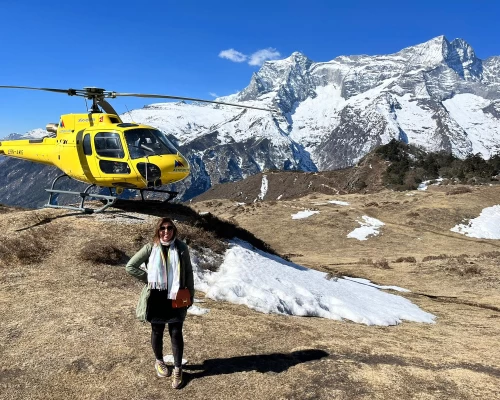
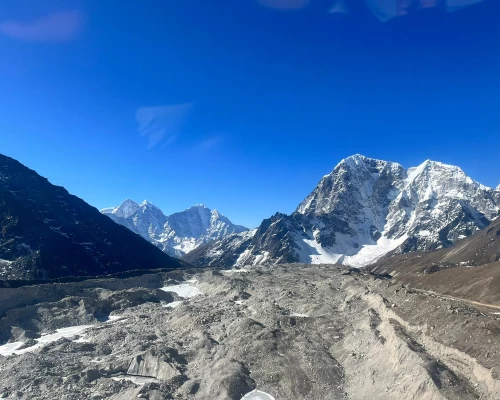
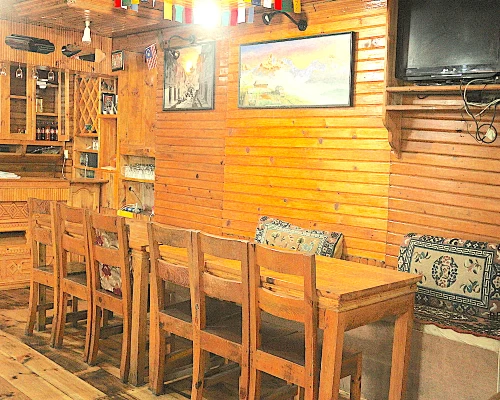
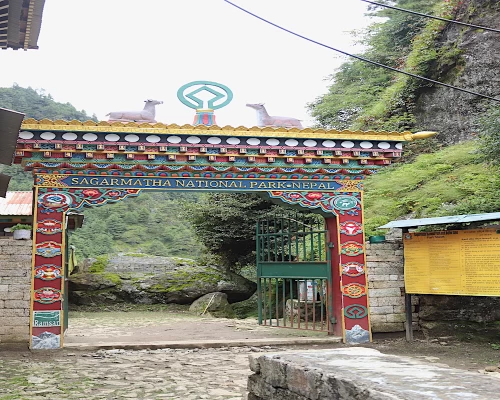


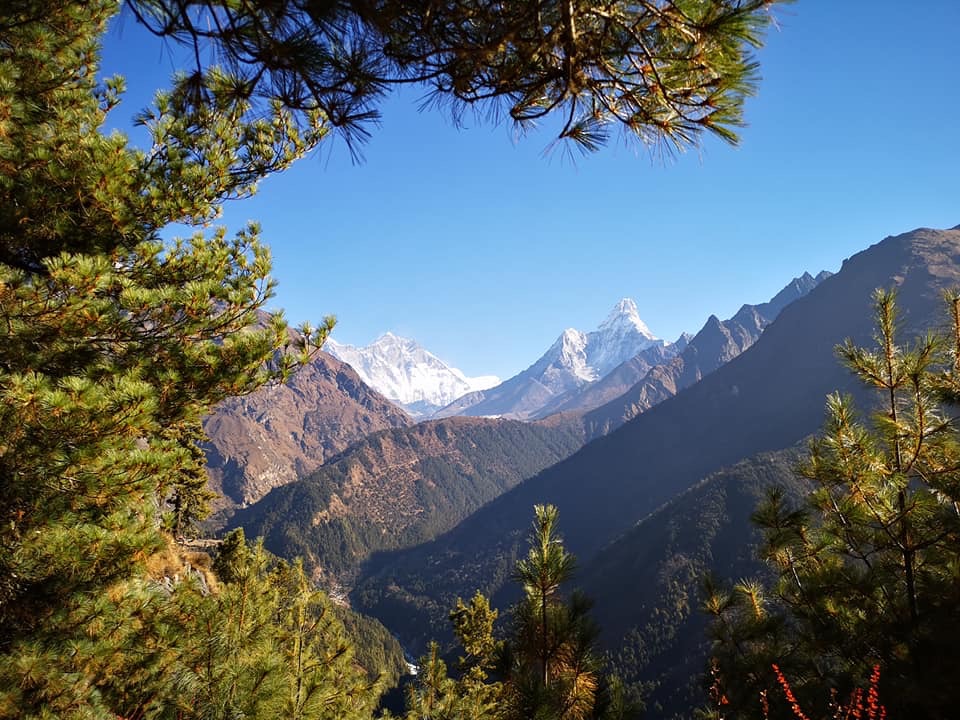
.JPG)



